Virtua Fighter 4 Preview
Sega's premier fighting franchise kicks it up on the PlayStation 2.
Since its debut in arcades in 1993, the Virtua Fighter series has consistently driven arcade technology and the development of the 3D fighting genre. The series has introduced motion capture, reversals, multilevel arenas, and the use of polygons in fighting games over the course of its various incarnations. As other fighting genres have emerged, VF has remained a respected series that has emphasized technique over button mashing. Considering the series' bleeding-edge arcade roots, it's always been a challenge to bring the games to home systems, given the limitations of the consoles; however, the quality of home conversions has improved in the wake of the introduction of more powerful console hardware into the market. As a result, the upcoming home version of Virtua Fighter 4 for the PlayStation 2 is shaping up to be one of the finest VF conversions to date thanks to excellent graphics, tight gameplay, and extra modes not found in the arcade.
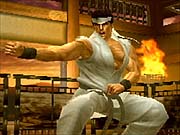
The game has 13 fighters entering the fourth World Grapple Tournament. Those who have followed the Virtua Fighter series will recognize 11 of the fighters: Kung Fu teacher Akira Yuki, action star Pai Chan, cook Lau Chan, wrestler Wolf Hawkfield, fisherman Jeffry McWild, ninja Kage Maru, student Sarah Bryant, Indy car racer Jacky Bryant, herbal doctor Shun Di, college student Lion Rafale, and college student Aoi Umenokouji, last seen in Virtua Fighter 3 and Virtua Fighter 3 Team Battle. In addition, two new faces now join the cast: security officer Vanessa Lewis and monk Lei Fei. The roster of fighters for VF4 marks a slight change in tradition for the series. Each new installment typically includes the entire cast from the previous VF game plus two new fighters. This gradual growth of the roster has stemmed from AM2's desire to maintain the game's play balance. However, fans of VF3's sumo, Takaarashi, will find that he is nowhere to be found in VF4.
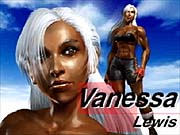
Taka's omission and the addition of Vanessa and Lei Fei do little to affect the game's story, which is still barely there and remains one of the game's weaknesses. Unlike the Tekken series, Virtua Fighter has never placed much emphasis on its story. To discover the characters' various backgrounds and relationships, you have to read through their biographies in the game's manual and follow the various comic books and anime that have cropped up over the years. The closest the series has come to offering any bit of information on the characters' backgrounds in the actual game was the CG movie at the end of Virtua Fighter 3tb for the Dreamcast. As a result, many players have missed out on the history of the characters in the game. For example, Pai is Lau's daughter and isn't too fond of her father. Sarah is Jacky's sister, and she was kidnapped and brainwashed by the same mysterious organization responsible for creating the game's boss, Dural. Jacky enters the tournament in the hopes of rescuing her. The search for a loved one has also played a part in Kage's previous entries in the competition--his mother was kidnapped and transformed into Dural. After rescuing her at the end of the competition in VF2, he returned to fight in VF3 to face a new Dural in the hopes of discovering a cure for his mother's health problems from her time as Dural. Other relationships in the game are less complicated; for instance, Aoi enters the tournament to test her fighting skills alongside childhood friend Akira. The lack of contextual background info doesn't really ruin anything but it is missed. Hopefully AM2 will see fit to include a CG movie along the lines of VF3tb's to offer some background information.
In terms of the game's graphics, VF4 is arguably the best-looking PlayStation 2 fighter yet. Developer AM2's reputation for working miracles with challenging hardware should remain intact once gamers get a look at VF4 running on the PS2. With its generous polygon budget, the game boasts some truly impressive visuals. The fighters' character models sport a high amount of detail, ranging from their detailed faces to the ornate patterns on their clothing. The series continues its trend toward realistic graphics by giving the veteran characters an "older" look and feel to reflect the passage of time. You'll find that the old crew looks older. The lines on Akira's face give you the impression he's lived a little since the last tournament, where he appeared freshly shaven. Facial animation is much improved thanks to the use of technology from another AM2 title, Shenmue--it's the most emotive it's ever been in the series, and it offers solid lip-synching. Clothing in the game improves on VF3's look with smoother movement--such as when swaying in the wind or moving with the characters' actions--and an amount of detail so high you can make out fine patterns on the individual pieces of clothing worn by some characters. Finally, hair looks and moves far more realistically than ever before--everything from the subtle bob of Jeffry's dreads to the loose strands in Sarah's ponytail adds to the game's fluid motion.
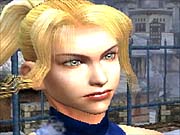
The backgrounds in the game fare just as well, making the most of their polygonal allotment. You'll find a total of 16 arenas in the game, one for each character, including Dural's final stage, and two original arenas created exclusively for the game. Each arena is large and features at least one bit of eye candy that keeps things visually interesting. Akira's stage, a ring set in the interior of a dojo, features separate lighting schemes to reflect the different times of day. Pai's arena, set in an underwater aquarium, is surrounded by a variety of sea life seen through the aquarium's glass walls and has shafts of light coming in through the various windows. Lau's area, a remixed version of his Great Wall of China stage from VF3, features an impressive vista, reflective pools of water on the ground, and flags swaying in the wind. Wolf's arena is a square cage surrounded by a throng of cheering spectators in a smoky room, with a spotlight panning over the crowd. Jeffry's island stage features seagulls flying in the sky, a large plane bobbing in the water, and sand in the fighting arena that kicks up and deforms according to the movement of both fighters in the ring.
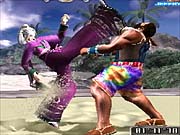
Kage's garden stage, a ring reminiscent of a Buddhist temple in Japan, is surrounded by statues and covered in leaves that kick up as both fighters duel in the ring. Sarah's colosseum stage, a ring set in the center of an ancient Roman-style colosseum, reminiscent of her VF2 stage, is slowly being destroyed by bolts of lightning that illuminate the area and bring down chunks of the structure in the background as they strike. Jacky's city stage is one of the game's most impressive stages. Set on the roof of a building at night, the arena is dramatically illuminated by circling helicopters that train spotlights on the fighters during battle.
Shun's cave arena is a bamboo cage built above a pool of water in a cave and ringed by candles. Lion's rooftop castle stage features falling snow, waving flags, and a mass of snow in the ring that deforms and kicks up in much the same way as the sand in Jeffrey's stage does. Aoi's shrine stage is ringed by a walkway and surrounded by water that offers some nice reflection effects. Lei Fei's rooftop temple stage offers flocks of birds, glare from the sun, and tiles on the arena floor that can be broken during a match. Vanessa's harbor stage is a ring built over the water and surrounded by boats and a light mist. Dural's stage features a moving ring and some nice lighting effects that are a good showcase for her chrome body's reflective properties. The new outdoor area seen in the training mode, and which occasionally pops up as a stage in versus battles, is a bit low key when compared to the rest of the game's stages. It's a simple area in a warehouse surrounded by girders, and it has a slight orange glow to it--seen in light that filters through the building's windows. Finally, the other new outdoor area features a water-filled ring at the center of a courtyard--it shows off some nice water and particle effects via the water's reactions to the actions of both fighters.
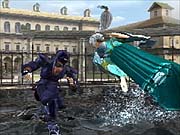
Outside of the visceral appeal of VF4's graphics, the game has a much more cinematic presentation than previous entries in the series. The swooping fly-throughs showing off each level and the opening taunts from each fighter, in all likelihood influenced by AM2's work on the Shenmue games, are effective at pulling you into the game. The impressive camera work is also noticeable during certain moments in a fight, such as when one combatant pulls off a throw, which causes the camera to come in and give you a close-up look at the brutal throw animation. The camera also switches during a replay after a fight, offering a more handheld feel and tracking the action from different camera angles to keep things visually interesting. The added cinematic feel to the game really gives VF4 an extra layer of polish that suits it well.
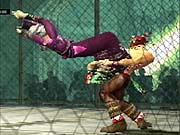
Now, as impressive as the visuals in VF4 are on the PS2, they still aren't quite arcade perfect. Though the 10 million polygons per second the Naomi 2 arcade hardware (which the game was developed on) is capable of pushing should be well within the realm of what the PlayStation 2 hardware is capable of handling, things aren't quite that cut and dried. The Naomi 2 hardware has the benefit of a geometry processor dedicated to handling transformations and lighting, which allows for up to six light sources to be used while it's pushing those 10 million polys. The benefit of a dedicated geometry chip is that all transform and lighting calculations that would have been done by the main processor are offloaded to the geometry chip and free up the main CPU's resources to handle physics, artificial intelligence, collision detection, and the rest of the game code. As powerful and versatile as the PS2's Emotion engine and vector units are, it's doubtful they'll be up to the task of matching the Naomi 2's performance. While our preview build of VF4 wasn't quite complete, it's pretty clear that some compromises are being made.
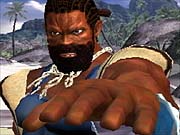
There's nothing tremendously earth shattering being lost in the translation to the PS2 version, such as the way the 3D backgrounds were lost in VF2 on the Saturn, but the game doesn't look as though it's going to have arcade-perfect graphics. The game looks a bit jaggier than the arcade version, which is especially noticeable in the characters' shadows. Fences and floors have moiré patterns that are more prominent from certain camera angles. Certain distant background elements that were 3D in the arcade have been replaced with 2D bitmaps. Color is a bit washed out, lacking the rich depth found in the arcade. The textures, while surprisingly detailed for a PS2 game, are off a bit, although they're not so bad on a television's resolution. The deformation and particle effects of the sand and snow have been scaled back. The sand looks as though it may take a bigger hit than the snow because, at present, it's much flatter and deforms less. The snow deforms well, but there's just less of it to go around in the castle arena. Probably the most noticeable tweak is in the lighting. As mentioned earlier, the PS2 isn't quite the polygon lighting machine the Naomi 2 is. A lot of the more dramatic stage lighting has changed and been scaled back or faked. To compensate for some of the losses, some tweaks have been made to freshen up the game's look on the PS2. Some of the characters--Sarah, Vanessa, Jeffry, and Wolf, for example--are shinier in places. In the case of Sarah, it looks like her blue one-piece outfit is made of vinyl, while Vanessa, Jeffry, and Wolf look as though they've seen some action with copious amounts of baby oil. The game will also satisfy gamers who either loved or hated the blue and yellow impact flashes that were triggered during a fight to reflect specific types of hits. Those who loved them can go to the settings menu in options and turn them on, while those who didn't care for them can leave them off. Finally, fog and mist have been implemented in many levels--Sarah's, Vanessa's, and Lei Fei's for example--for effect. In spite of all the graphical nips and tucks, though, the game is coming along quite well. Given what AM2's been able to pull off in the past, we're extremely curious to see what the final game will look like.

While the graphics in VF4 may not be arcade perfect, the gameplay is incredibly tight. The series returns to its three-button roots, losing the escape button introduced in VF3 but incorporating the 3D-movement functionality from VF3's control scheme. The default control map will have you using the D-pad for movement. Holding up or double-tapping down will let you move around your opponent in 3D. Holding up and pressing punch or kick will let you jump and perform different types of landing attacks. The square button will block, triangle will punch, and circle will kick during a fight. The X button can also be used to punch, while the triggers will serve as different combinations of button presses to give you some flexibility. If that setup isn't to your liking, you'll find two other presets to choose from as well as an edit feature to let you set things up exactly the way you like them.
You'll find a fine selection of modes in Virtua Fighter 4 that will let you hone your fighting skills. Besides the basic arcade mode, which will pit you against all the fighters on your way to Dural, you'll find a data files option, an AI system mode, versus mode, kumite mode, and an excellent training mode. The data files option is easily the game's coolest extra feature--it re-creates the VFnet magnetic card system used in Japanese arcades. For those who haven't followed the game in Japan, the VFnet card system lets you purchase a card in the arcades, which you then insert into VF4 arcade machines. Once you assign a specific character to it, the card keeps track of your stats as you fight against other players. While the stat tracking is cool, the big draw is the ability to earn new items--which are saved to the card--for customizing your character's appearance, including color schemes, accessories, and VF1-style character models.
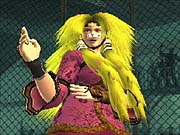
Unfortunately US gamers were denied this feature when the VF4 arcade was released in the US without the card system. However, all is forgiven with the inclusion of the system in VF4 for the PS2. On the PS2 you'll use your memory card to create a character file. A nice perk is that you'll be able to have multiple character files on one PS2 memory card, unlike with the magnetic cards in Japan, which only save one fighter per card. You'll simply hop into the data files option and choose to create a new player. A text input screen will let you enter your own ring name of up to 10 characters. Once you've settled on a name, you'll select which of the fighters you want to use, and then you're set.You'll repeat the process for each fighter you'll want to create a file for.From then on, when you're in any of the different modes, you'll press the select button at the character-select menu to access your memory card's saved fighters and choose the one you want. In addition to creating custom fighters, you'll also be able to create AI fighters. The process for creating an AI fighter is the same as for creating a custom character, but an AI character has very different uses.
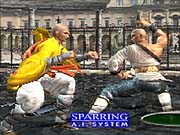
The AI system mode in VF4 lets you actually teach your AI character how to play the game. You'll have three options for training your character. If you select sparring in AI system mode, you'll fight against your AI character. The character will "learn" from your actions as you attack it since you'll be playing as the same character. A window at the bottom of the screen will let you know when your character is learning a move off of you. Your second training option is to have your AI character go through kumite mode or versus mode. You'll have no direct control over your character as it fights matches; instead, you'll see the same window you see when sparring onscreen during a fight. As the match progresses you'll be asked for feedback via the X and O buttons.
Pressing the O button will tell your AI character its current mode of attack is correct, while the X button will tell it that its current attack style is wrong. If you save your replays to the memory card, you can watch them in the replay mode found in the AI system option menu and coach it there by using the same X and O button method. It's a cool but spooky feature, as you see your little virtual minion start to learn how to fight effectively.
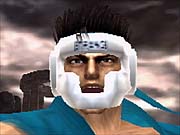
Versus mode is exactly what you'd expect, a fight against a friend. Thanks to the ability to use custom characters in addition to the basic roster of fighters, the mode offers a lot of potential fun as you try out your best characters against each other. Kumite mode is an endless barrage of matches against random fighters of varying skill, so it offers a perfect sense of what it's like to play VF4 in Japanese arcades. The mode provides excellent practice, and it's one of the places where you'll be able to earn items for your fighter. As you progress through the mode you'll occasionally notice a treasure chest materialize at the bottom of the screen during your fighter's win pose. The chests alert you that you've gained something to use on your fighter. If you pop into the data files option menu and go to edit file, you'll be able to check out the items and outfit colors that are available for you to use. The amount of customization possible for a fighter varies with each character. Some will have more options than others depending on the type of outfit they're wearing. For example, Lei Fei has a lot of options for customizing the color of his outfit because of its many layers, while Aoi can only customize her top or pants because of their simple design. Fortunately you'll find a wealth of accessories for most fighters, ranging from the cool (sunglasses) to the bizarre (motorcycle helmets). It also appears that some items will give your fighters new moves, which is something we weren't able to verify in our time with the game.
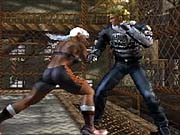
The final mode in VF4 is the training mode. While training modes are fairly standard in fighters these days, VF4's bears mentioning for its excellent execution. You'll find three training options in the mode: command, free, and trial. Command has you matching controller inputs that appear onscreen as you go through all of a character's moves. The really nice thing is that, should you be unsure how to perform a move, you'll be able to have the game show you how to do it via a short real-time clip. Free lets you do your own thing and kick someone around an arena until you're satisfied. Finally, trial will present you with a series of timed challenges to test your fighting skills. The mode is very well done and should be an invaluable resource for those interested in getting into the deeper levels of play in the game.
So far we're extremely pleased with the way VF4 is coming along on the PS2. The game handles nicely and looks great. The extra features certainly give it replay value beyond a no-frills port of the arcade game. So far our only gripe is the lack of any attempt to push the game's story a bit more. It seems like a shame to waste all the character development that's gone on behind the scenes. While it would be nice if AM2 tightened the graphics up even more, we're cool with the way the game is looking now. It may not be arcade perfect, but it's light years closer to its arcade brethren than earlier home versions of the VF series were. Gamers looking for some virtua fighting for their PS2 can look for Virtua Fighter 4 this March.
Got a news tip or want to contact us directly? Email news@gamespot.com
Join the conversation